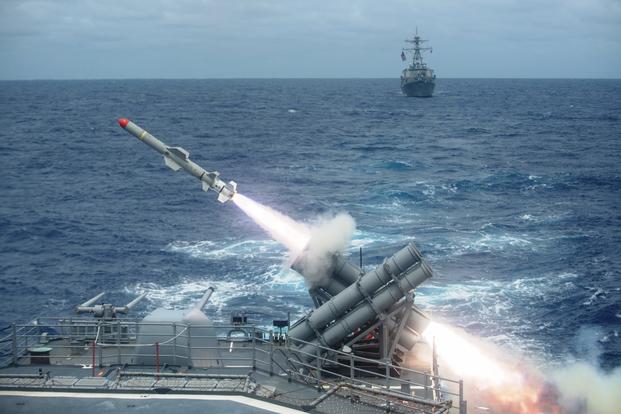Boeing Co. is recommending that new Littoral Combat Ships be mounted with Harpoon missile launchers this year before routine trials near Mayport, Florida, a company official said.
In a recent interview with Military.com, Jeffrey "Scott" Jones, Boeing's global sales and marketing lead for the Harpoon and a retired Navy rear admiral, said a new upgrade kit that aims to double the missile's range makes it a strong candidate for mounting on the LCS and the frigate that will follow.
The Navy's director of surface warfare, Rear Adm. Peter Fanta, called an over-the-horizon missile an "absolute requirement" for the ship in a January interview with USNI News, adding that Harpoon was one of the systems under consideration to do the job. Fanta said he wanted to mount a missile on the LCS by the end of this year, for demonstration purposes at a minimum.
The service completed free-flight tests in November on the Harpoon Block II+ missile, a network-enabled upgrade expected to be delivered to the fleet by 2017. The Block II + ER kit, Jones said, will offer doubled range at half the cost of a new missile acquisition -- and with a fairly rapid upgrade turnaround process.
Boeing is waiting on a Navy decision regarding introduction of the upgrades to surface ships, Jones said, but added the company could start installing systems on ships "very soon."
The Harpoon has its critics, however. In a January briefing with reporters, Lockheed Martin vice president of Littoral Ship Systems called the missile a "worst-case scenario" for the LCS, saying that government officials "believe anything other than that would come in equal or lighter, basically."
Jones said Boeing had actually offered the Navy a variety of launching systems for the Harpoon, including the lightweight MK 140 launcher used on the service's Pegasus-class hydrofoils and on a number of international ships. That launcher, which he said will make the missile system come in at 4,000 pounds less than the 22,500-pound maximum weight listed in the Navy's formal request for information, is the one Boeing recommends that the Navy use.
"Harpoon would be one of the lighter options for the LCS," he said.
Jones pointed to several anecdotal stories that he says prove the launcher's hardiness and resiliency. One involves the 1979 mishap in which the USS Pegasus, the first of the class of hydrofoils in commission between 1977 and 1993, ran aground on a sandbar doing 40 knots at the mouth of the York River, near Hampton Roads, Virginia.
"You kind of come to an abrupt stop," Jones said.
But on the back of the hydrofoil, he said, the two Harpoon missiles in their lightweight launchers remained intact.
The same was true, he said, when another hydrofoil, the Aquila, struck a whale off the Florida coast in 1991, causing $1 million in damage; and when the South Korean ship ROKS Cheonan, a Pohang-class corvette, split in two and sank in March 2010 as the result of an explosion.
"The Navy would eventually have to do a shock trial test of that design, but there are three operational events that we have shown the Navy as an example to fill that requirement," Jones said.
Another advantage with the Harpoon, he said, was that the system was a proven all-weather weapon, a key consideration for surface ships.
"If we ever have that demonstration that Adm. Fanta wants us to have," Jones said, "Let's do it in the rain."
--Hope Hodge Seck can be reached at hope.seck@monster.com. Follow her on Twitter at @HopeSeck.
Related Video:






























